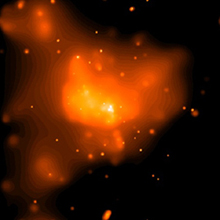February 1, 2001
PSU Press Release
10 January 2001 -- Scientists using NASA's Chandra X-ray Observatory have discovered that an apparent supernova remnant in the center of our galaxy might help regulate a nearby supermassive black hole and that such relationships between supernova remnants and black holes might be common throughout the universe.
The scientists studied Sagittarius A East, previously known by its ring-shaped radio emission, located nearly 26,000 light years from Earth in the constellation Sagittarius. Sgr A East appears to surround the black hole Sagittarius A* (denoted with an asterisk because it is a point source that emits radio waves) with its center offset by about six light years from that of the black hole. Using Chandra, scientists were able to separate Sgr A East from other complex structures for the first time in X-ray wavelengths. The properties they discovered support the long-standing hypothesis that Sgr A East is a single supernova remnant that exploded about 10,000 years ago.
"With Chandra, we found hot gas concentrated within the larger radio shell of Sgr A East," said Yoshitomo Maeda, an astronomy and astrophysics research associate at Penn State who presented the research team's results at the 197th national meeting of the American Astronomical Society in San Diego, California, on 10 January 2001. "The gas is highly enriched by heavy elements, with four times more calcium and iron than the Sun, and that confirms earlier suspicions that Sgr A East is most likely a remnant of a supernova explosion. While dozens of supernova remnants are known in our galaxy, the proximity of Sgr A East to the black hole in the center of our galaxy makes it important."
After a supernova explosion, scientists believe two shock waves are formed, with one moving inward and one outward. The inward shock wave heated up the ejecta that was detected with X-rays by the Advanced CCD Imaging Spectrometer (ACIS) aboard Chandra. The temperature of gas in that shock wave was measured at 20 million degrees by Chandra. Scientists believe the outward shock wave moved the cooler, heavier gas that comprises the intergalactic medium--compressing and plowing that gas past the black hole as the shock wave spread and feeding the black hole in the process. They believe the result was a period of intense feeding of material into the black hole, followed by a period of black hole "starvation."
"The important question to be raised here is what effect the plowed gas has on its environment," said Frederick Baganoff, a research associate at Massachusetts Institute of Technology and lead scientist for Chandra's Galactic Center project. "It is possible that the plowed gas has passed over the supermassive black hole at some time in the recent past. During the passage, a lot of gas could have been captured by the black hole."
When black holes pull matter inward, they are able to accelerate those particles to almost the speed of light. The matter accreting into a black hole releases a great deal of energy, much of it in X rays that can ionize the surrounding gas and make it visible with instruments such as ACIS. Because X-ray emissions from the black hole are weak at this time, scientists believe the shock wave already has passed by the black hole.
"Radio astronomers already found that the gas in a halo surrounding Sgr A East and the supermassive black hole is largely ionized," said Mark Morris, professor of astronomy and physics at the University of California at Los Angeles. "If the gas plowed by the supernova remnant was pushed past the black hole, the spectacular interaction would very possibly have occurred as recently as a few hundred years ago, and the resulting flash of energy would likely have irradiated and ionized the surrounding gas. This could explain why the ionization of the gas still survives."
In a broader sense, that activity might serve as a model for other black holes and other phenomena throughout the universe because the Chandra scientists suggest supernova explosions might regulate the activity of those phenomena. Many scientists believe black holes thrive at the center of most galaxies and when those black holes accrete material, scientists can detect an active galactic nucleus with X rays. According to the Chandra scientists, individual supernova explosions might be relevant for providing material that activates the accretion activity of black holes, thereby turning the active nucleus on and off.
The Chandra observations were made 21 September 1999 using ACIS, which was conceived and developed for NASA by Penn State and Massachusetts Institute of Technology under the leadership of Gordon Garmire, Evan Pugh Professor of Astronomy and Astrophysics at Penn State. NASA's Marshall Space Flight Center in Huntsville, Alabama, manages the Chandra program. TRW, Inc., of Redondo Beach, California, is the prime contractor for the spacecraft. The Smithsonian's Chandra X-ray Center controls science and flight operations from Cambridge, Massachusetts. The ACIS detector is a sophisticated version of the CCD detectors commonly used in digital cameras or video cameras.
Chandra carries an X-ray telescope to focus the X-rays from objects in the sky. An X-ray telescope cannot work on the ground because X-rays are absorbed by the Earth's atmosphere. The Chandra X-ray Observatory is the third of NASA's "Great Observatories," following the Hubble Space Telescope and the Compton Gamma-Ray Observatory.
Along with Maeda and Garmire, the Penn State contingent of collaborators for results of this research presented at the astronomical society meeting comprises: Niel Brandt, David Burrows, Eric Feigelson, and Leisa Townsley. Along with Baganoff and Morris, other collaborators include: Mark Bautz, John Doty, and George Ricker from Massachusetts Institute of Technology; and Steve Pravdo from the Jet Propulsion Laboratory.
This research is supported by NASA contract NAS 8-38252 and, in part, by the Jet Propulsion Laboratory, under contract with NASA.
Images associated with this release are available on the World Wide Web at:



